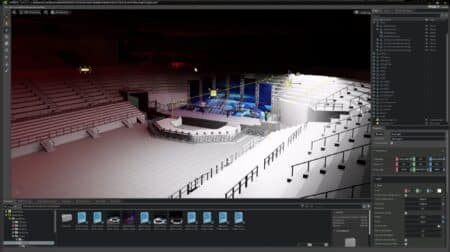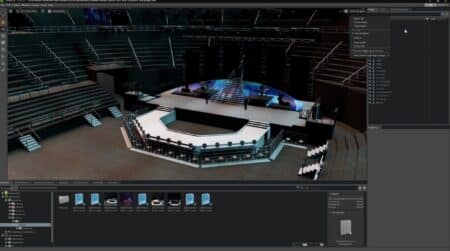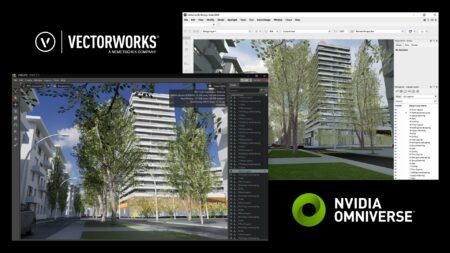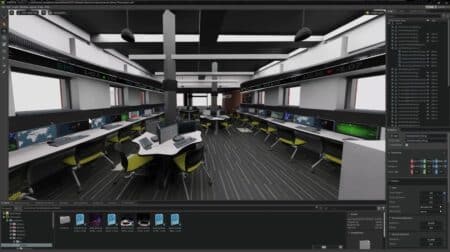VECTORWORKS IS ONE OF THE FIRST Nemetschek Group companies to embrace the NVIDIA Omniverse with an Omniverse Connector. More are sure to come, but for now, Dave Donley, Senior Director of Rendering and Research of Vectorworks, Inc., tells Architosh that its users will find their favorite CAD/BIM tools of choice will rapidly expand with new workflow options.
Network Effects for All?
Typically so-called “network effects” accrue around a market share leader, leaving the crowd chasing that leader to compete by offering creative core innovations and more value in exchange for the benefits of the expanding network. It’s a story in the technology industry that has been well-worn for over four decades.
But this time, NVIDIA—known as a semiconductor (chip) company and a leader in GPUs (graphics processing units)—has positioned itself and its Omniverse technology as a solution for removing data silos across numerous industries, including AEC/O, manufacturing, and landscape.
“I think there are many stories,” says Dave Donley, speaking about how Omniverse will positively impact Vectorworks. “One story is—if you look at the chart of [Omniverse] Connectors—you see a ‘multiplication factor.’ The combinations that you can produce using the 100 or so plugins that connect to Omniverse today are a bit of a ‘choose-your-own-adventure.’ We are looking at a heady future with Omniverse.”
Donley is right. NVIDIA’s Omniverse is expanding exponentially, with more and more industry software tools forming connections to it so that their users can leverage the power of the Omniverse.
The Omniverse, Explained
For the uninitiated, NVIDIA’s Omniverse is a virtual collaboration platform based on a robust open standard known as USD (Universal Scene Description) created by Pixar Animation Studios. We will get into the power of USD further down the article, but it is essential to unpack the Omniverse for now. Omniverse is NVIDIA’s name for its metaverse platform and technologies.
The combinations that you can produce using the 100 or so plugins that connect to Omniverse today are a bit of a ‘choose-your-own-adventure.’ We are looking at a heady future with Omniverse.
With the Omniverse, designers, architects, engineers, and others can work together on complex 3D models and simulations in real-time. It does this by functioning as a hub at the center of a set of software technologies that enable individuals and teams to collaborate using their favorite software tools. An architect could use BIM tool A, a structural engineer uses a structural BIM tool, a civil engineer uses their 3D CAD tool, while an interior designer and landscape architect use their favorite tools. And yet, magically, everyone can collaborate on a single federated model because each software can communicate with the Omniverse.
The technical underpinnings of the Omniverse are explained here in this Architosh article dedicated to the topic. The critical point is that the Omniverse is fundamentally an “open” technology that de-silos tools and data, similarly to Zoom de-siloing people and teams during the global pandemic.
AEC/O Industry Problems
Siloed data in the AEC/O industry has been, and continues to be, the crux of the industry’s productivity problem.
Yet, Omniverse looks staged to potentially really change that. “There is far less siloing in the Omniverse,” adds Martyn Horne, Director of Product Marketing of Vectorworks. “That’s the irony since the pandemic happened. We all became unique individual silos, but in becoming so, the pandemic broke down some of those larger silos.”

The Omniverse Connector will greatly expand workflow options for Vectorworks users across its many industry verticals, including, importantly, Vectorworks Spotlight in the Media & Entertainment (M&E) industry.
“The Omniverse is different,” adds Donley, “in that it is not just a BIM cloud, not just for the building industry. You are going to bump into various industries using the Omniverse.” Donley notes that Vectorworks users from various sectors will bump into what may seem like non-adjacent sectors. “Architects using the Omniverse will bump up against the world of manufacturing, or entertainment and media,” he insists. “And that’s good for our users because they are involved in all those industries.”
Asked what AEC/O industry pros will likely work with each other via the Omniverse, Donley says, “I see real opportunities with civil engineers working with architects and landscape professionals in early stages and master planning.”
“Buildings don’t exist in vacuums as they appear in many BIM tools—a complaint that exists in the AEC industry,” he adds. “Architects will be able to federate their building models from BIM tools with the 3D terrain models from civils inside the Omniverse and better understand the site context of their projects.”
AEC/O Opportunities
And while today’s site context means a static understanding of the nature of things surrounding a building, Donley says the Omniverse descends from technology companies involved in games and movies.
“In games, you have real-time rendering, characters, and thus physics. There is also simulation,” he adds. “I expect more structural integration inside the Omniverse for AEC in the future because structural engineering is about physics and simulation. And we are already seeing this with the digital twins of factories created in the Omniverse.” (see: Architosh, “BMW expands NVIDIA Omniverse digital twin usage,” 29 Mar 23).
Another opportunity in AEC/O is in visualization and advanced visualization and media. While many new real-time interactive rendering tools have emerged to help democratize rendering workflows in design firms, many firms also tap the expertise of dedicated visualization studios. Architects can work with Omniverse to have a more iterative workflow with archviz consultants using different tools.
“The most integrated renderer in Omniverse beyond the RTX technology—other than Pixar’s RenderMan—would be Maya,” adds Donley. The Omniverse movement also must workout—and may indeed accelerate—standardization in rendering around material standards “because there are multiple standards out there in the industry,” says Donley.
The fact that materials, textures, and lighting is all in the USD environment is significant. That sort of thing doesn’t come with IFC.
We are aware from sources, including NVIDIA, that the chip company is making efforts to bring groups together to standardize processes and technology in the visualization world.
And addition to the sheer horsepower—meaning industry leaders behind Omniverse—what Horne and Donley both emphasize is that what sets the Omniverse and USD apart from the past is its extensive and open nature.
IFC and Open USD
And speaking of “open.” As a Nemetschek Group company, Vectorworks champions Open BIM and other open industry standards. A natural question emerges about how the Omniverse with Open USD can integrate with the AEC/O industry’s IFC standard in BIM.
During NVIDIA’s latest 2023 April GTC event, on a press-only Zoom event, the tech chip giant said they are working on integrating the IFC schema into the USD format. Donley tells me that USD is a flexible container for data, and the big decision is about how to standardize the IFC data schema within the USD format—how to structure that.
USD brings such substantial advantages to interoperability and collaboration, and scene sharing. “The fact that materials, textures, and lighting is all in the USD environment is significant,” says Horne. “That sort of thing doesn’t come with IFC. So it is great that NVIDIA is working to bring IFC into USD, and it creates some wonderful possibilities.”
The Vectorworks Omniverse Connector is what Donley calls a “uni-directional connector.” You take Vectorworks source data, and you federate it within Omniverse. To get data back from the Omniverse back to Vectorworks, you import the USD file again.
“You can also track things because the revision history is included,” he adds. “If I move a wall or change a color, that becomes part of the revision history, which is also non-destructive, so you can always roll back to previous versions.”
The Mac and Omniverse
There is more coming to the Omniverse Connector in an upcoming Vectorworks update, but one thing that Vectorworks users may already catch onto is that the Vectorworks Omniverse Connector is currently only for the Windows version of Vectorworks. Dave Donley explains why:
“There is not yet a Mac SDK for the Omniverse,” he says. Now this may change in the near future, but one thing that should be pointed out—and this is clear to anyone who takes a deep dive on NVIDIA’s website—and that is within the Omniverse, there is always an RTX GPU involved somewhere. It can be in the cloud or inside a PC workstation, but it exists.
There are no NVIDIA RTX cards in modern Macs today. This may change, or perhaps the upcoming real-time raytracing hardware acceleration in future Macs will enable new possibilities. Either way, the need for platform parity matters to Vectorworks and its customers.
“We say ‘design without limits,’ so I don’t like the current platform limitation of this, and we are looking keenly to remove it for our macOS customers,” adds Donley.
Vectorworks Opportunities
But there are possibilities, and Donley admits there are some interesting ways they can solve the Mac parity problem. “There are some exotic opportunities for Mac Vectorworks users to connect to a server version running in the cloud possibly,” says Donley. “We might also look at browser-based streaming; we are keeping an eye on this very closely because we definitely want to continue to serve our Mac users very well.”
So while the company and time both shape the future of its Mac, users can capitalize on the NVIDIA Omniverse. The next update to the Vectorworks Omniverse Connector will support LiveSync. “You will be able to see live interaction between Vectorworks and Omniverse,” says Donley. And USD has a technology called Hydra that supports alternative rendering engines and Vectorworks partners, like Redshift and Unreal.”
I think BCF is important and maybe a way for us to talk about two-way tracking of issues.
Opportunities with Omniverse continue to expand. Martyn Horne mentions how data interaction may factor out with technologies like BIM Collaboration Format (BCF). “I think BCF is important and maybe a way for us to talk about two-way tracking of issues.”
“We also see a rich set of possibilities with simulations,” adds Horne. “We have talked about City Engine and architects, but there are additional simulations like weather, traffic, pedestrian, and mass crowds,” he adds. “Modeling—dare I say it—flooding is potentially very useful and important for architects or engineers.”
And finally, there is AI (artificial intelligence). “Yes, I didn’t want to forget the AI side of things,” says Donley. “There is already technology for text-to-image models, et cetera. We see a rich set of possibilities.”

IFC integration into the USD file format that powers the Nvidia Omniverse is key development industry observers are watching closely.
In the final analysis, Vectorworks might actually benefit more from the NVIDIA Omniverse than some of its rivals. The CAD/BIM leader serves multiple BIM markets, from architecture, urban design and landscape to media and entertainment professionals. Having industry verticals with the benefit of the Omniverse now means its users can tap an expanding world of specific capabilities, all of which can interoperate and collaborate with Vectorworks’ scenes, models, and data. It may mean it allows Vectorworks to concentrate and deepen its verticals.
There is an enrichment factor that the NVIDIA Omniverse brings to its users—the power of its network effects and ecosystem. But this time, the enrichment from those network effects is unbiased, taking place equally with everyone through the openness of USD and the Omniverse.





